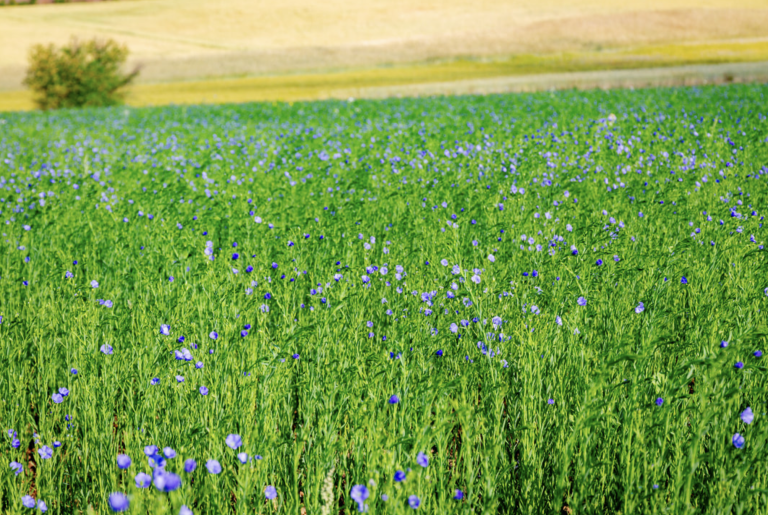How to Grow Flax: Advice from Farmers
Written by Sage Shelton
Fibers from the flax plant are used to make linen. Flax, like hemp and jute, is a bast fiber, which means that the fibers are derived from the outer cell layer of the stem of a plant. From a backyard garden to a production farm, there are many scales at which to grow flax. In this article, I will focus on backyard gardening and small-scale farming.
An Oregon Flax Field, Photo Courtesy of Fibrevolution
I interviewed Angela Wartes-Kahl of Fibrevolution in Corvallis, Oregon about her experience growing flax. Fibrevolution cultivates flax for seed and sources seeds from Europe for use by American farmers. Also interviewed was Zeke Overbaugh, a farmer based in Saxapahaw, NC, who’s growing a 0.15 acre test plot of flax this spring. I asked Angela who should grow flax, and her response was: “Patient people should grow flax. Ideally, someone who wants to grow flax would have some previous gardening experience.”
Selecting the Right Flax Variety
After deciding to grow flax, the next step is to choose which variety you’ll work with. Angela relayed that the most important part of choosing a seed is picking one that’s cultivated at a latitude similar to your own.
Flax seed is primarily cultivated in the Netherlands and in France. In an ideal world, someone cultivating flax in NC would select seed from southern Europe, which is at a similar latitude. Because seed stock is very limited in the U.S., it’s okay to simply work with whatever variety you can access. Through personal experience, I can vouch that Avian flax, though originating from the Netherlands, can grow in the Carolina Piedmont. This season, Zeke is farming with a general cover crop flax seed as well as a branched flax called Linore.
Selecting and Preparing Your Site for Growing Flax
When selecting a plot for growing flax, you’ll want to first consider whether you’ll be pulling by hand or using machinery for harvest. Since most hobby and research scale plots are harvested by hand, uneven terrain and some rockiness is acceptable. Angela noted that a soil with some clay content is very helpful, especially when growing a spring crop, because it helps with water retention during the hotter months. Accessibility to the plot is also a key consideration: will you be able to back a truck up to the plot when it’s time to take bales of flax to storage?
Once you’ve selected your seeds and your plot, the next step is to prepare the soil. Angela recommends growing flax in a given location every 4th year. This means that the plot will spend 3 years regenerating with complementary crops that build the soil back up. The year before planting a flax crop, Angela recommends growing buckwheat. Chopping the buckwheat down at least a month before planting and incorporating it into the soil along with manure or compost is a great way to prep the bed.
Zeke chose to prepare his bed by growing a winter crop of Austrian winter pea, which he tilled into the soil approximately three weeks before planting. He then amended the soil with a salt-based fertilizer as well as bone meal, feather meal, and blood meal.
Avian Flax Blooms, Photo Courtesy of Sage Shelton
If possible, it’s wise to take a soil test (depending on the time of year, the test may be free or cost $4 through your local NC Ag extension office) in order to assess whether nitrogen and other essential nutrients will need to be added. Angela shared that 80 lbs/acre of available nitrogen is ideal, anything higher could cause lodging in the flax plant. If your soil test reads 30 lbs/acre available nitrogen, you would then add 50 lbs/acre of nitrogen using an organic, all-purpose fertilizer. Use a rototiller to get the top layer of your soil loose. Try to break apart large clumps so that you’re left with a fine soil bed.
Weed Control
According to Angela, the best form of organic weed control is knowledge of what was growing in the plot before the flax. She said that grass is especially hard to keep from growing back in, so you would not want to rip up a plot of grass and immediately plant it with flax. Instead, remove the grass in advance and grow a crop like buckwheat to prepare the soil. In Zeke’s case, he removed Bermuda grass in the fall of last year, grew Austrian winter pea, and is growing flax two seasons after removing the grass. He’s noticing that some grass is coming back, which may outcompete some of his young flax plants.
When and How to Plant Flax
With your plot ready to go, you can choose when to plant. As a rule of thumb, if it’s warm enough to wear just a t-shirt outside then it’s time to grow flax. Once the daytime temperature is reliably 60°F, it’s a good time to plant. In NC, it’s common to plant in early-to-mid March.
When you’re ready to plant, measure out your appropriate amount of seed needed (typically 100 lbs of seed per acre). If the seed is more than a year old, use the rate of 150 lbs/acre to account for a potentially lower germination rate. Broadcast the seeds by hand as evenly as possible. Cover the seeds with soil, by either using a rake or a tiller. Then, tamp the soil down by either walking directly on the seed bed or covering the bed with plywood and walking on top. Flax seeds require a high level of soil contact in order to germinate.
In the first several days of growing, make sure your seeds get ample water. You’ll want your flax to receive precipitation of roughly 1 inch per week. If it does not rain, make sure to water your flax. Water is especially important during germination! Allow your flax to grow for approximately 100 days, or until at least half the stalk is yellow and the seed pods have turned yellow.
Harvesting Flax
Harvest your flax by hand, pulling it up from the root, and lay all the stalks down on the ground in the same direction to create a windrow. The last step in the field is to allow the crop to ret, which is a controlled rotting process. Naturally-occurring bacteria break down the components of the flax stem that act as a glue. Once the lignin is broken down by retting, the fiber can easily be separated from the rest of the stem in processing.
This process, called “dew retting,” takes careful attention. If retting goes too far, it can start to break down the fiber. To test the retting process, pick up a single stalk of flax and bend it in half. If the fiber easily separates from the rest of the stem, you know that retting has gone far enough. Depending on the level of humidity in your environment, dew retting could take anywhere from 2 weeks to 2 months. In NC, retting usually moves at a fast pace. Once retting is complete, dry the flax thoroughly in the sun. Then, bale the flax and store it away from moisture.
Stay tuned for our next piece on how to process flax to make linen from this beautiful plant!


